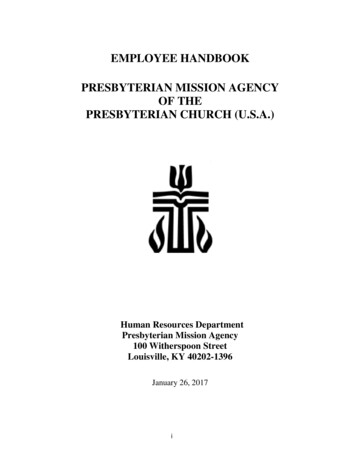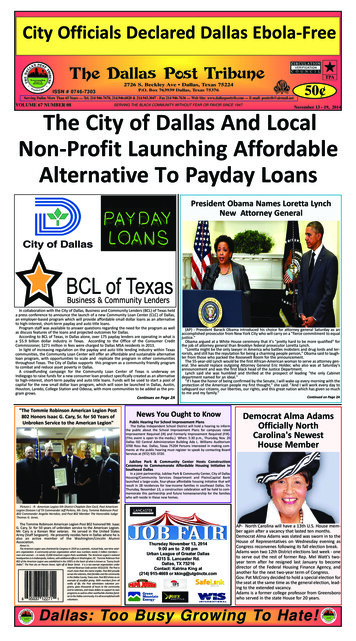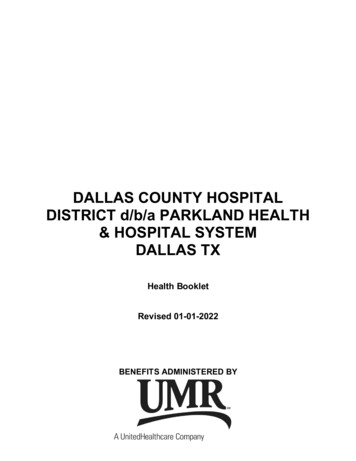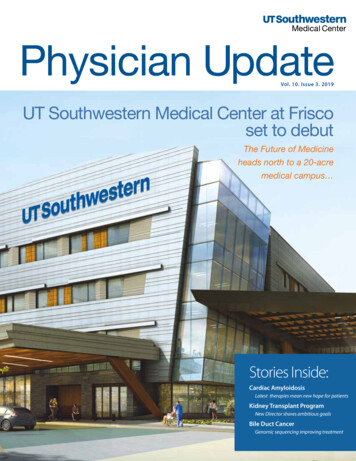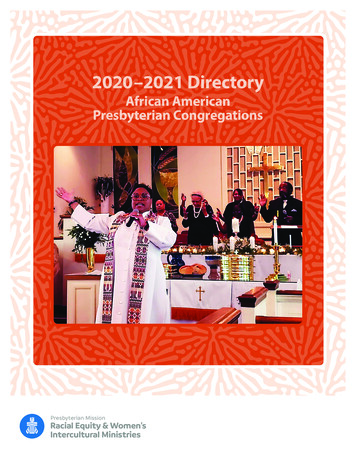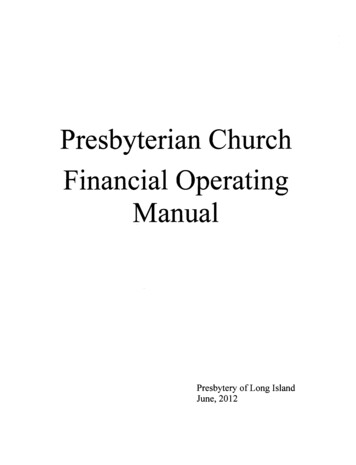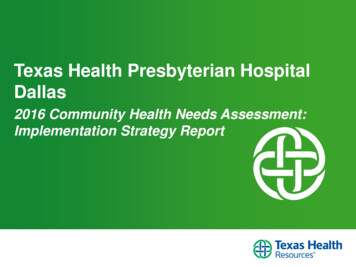
Transcription
Texas Health Presbyterian HospitalDallas2016 Community Health Needs Assessment:Implementation Strategy Report
Implementation Strategy OutlineReport Contents Background– About the Organizations– CHNA Overview– Implementation StrategyDesign Process Implementation Plan– Priority 1: Behavioral Health– Priority 2: Chronic DiseasePrevention and Management– Priority 3: Awareness, HealthLiteracy & Navigation– Priority 4: Older Adults &Aging2Appendix ContentsI. Project TeamII. Consulting Organization
Background
About Texas Health Resources4MissionTo improve the health of the people in the communities we serve.VisionTexas Health Resources, a faith-based organization joining with physicians, will be the health care system ofchoice.Values Respect – Respecting the dignity of all persons, fostering a corporate culture characterized byteamwork, diversity and empowerment. Integrity – Conduct our corporate and personal lives with integrity; Relationships based on loyalty,fairness, truthfulness and trustworthiness. Compassion – Sensitivity to the whole person, reflective of God's compassion and love, with particularconcern for the poor. Excellence – Continuously improving the quality of our service through education, research, competentand innovative personnel, effective leadership and responsible stewardship of resources.Your feedback on this report is welcomed and encouraged. Please direct any questions or feedback to:Texas Health Resources System ServicesCommunity Health Improvement612 E. Lamar Blvd., Suite 1400 Arlington, TX 76011Email: THRCHNA@texashealth.orgPhone: 682-236-7990
About Texas Health Presbyterian Hospital Dallas5Texas Health Presbyterian Hospital Dallas serves thecommunities of Dallas County and also treats complexcases from across North Texas with advanced medicaltreatments and an experienced staff that providescompassionate care.With a mission of improving the health of the people inthe communities we serve, Texas Health Dallas and thephysicians on its medical staff are committed to yourwell-being and the health and wellness of your family.Texas Health Dallas offers: Advanced Surgical Procedures Asthma Care Bariatric Surgery Behavioral Health Cancer Care Diabetes Care Digestive Health Emergency Department Fitness Center Heart and VascularHome HealthNeurosciencesOrthopedicsRehabilitationSleep MedicineSports MedicineWomen and InfantsCareWound CareTexas Health Dallas is designated as a Magnet hospital by theAmerican Nurses Credentialing Center, an honor that recognizeshospitals for excellence in nursing. Texas Health Dallas joins anelite group of three percent of U.S. hospitals to have beenhonored with Magnet designation multiple times.Texas Health Dallas was the first hospital in Dallas to receiveCycle IV Chest Pain Accreditation from the Society ofCardiovascular Patient Care and is also accredited foremergency stroke care by the Joint Commission. Texas HealthDallas was also named "Best Place to Have a Baby" in DallasCounty by readers of DallasChild magazine.Texas Health Dallas is an 888-bed, acute-care hospitalconveniently located on Walnut Hill Lane, just east of CentralExpressway (U.S. 75) in Dallas.
6CHNA & IS Process OverviewCommunity InputCollection &AnalysisSecondary DataAnalysisCHNAReportData Synthesis &Significant HealthNeedsPrioritization ofSignificant HealthNeeds In depth interviews and focus groups were conducted with individuals. An online community survey wasalso distributed to collect input on community health needs, assets, and barriers from community members.Each form of community input was analyzed, and significant health needs, barriers, and assets/resourceswere identified. The Healthy North Texas platform was leveraged along with PQI data from The DFW Hospital Council. HCI’sdata scoring methodology was used to compare indicator values at national, state, and county levels as wellas trends over time and HP2020 targets. HCI’s data scoring methodology was used to compare indicatorvalues at national, state, and county levels as well as trends over time and HP2020 targets. The qualitative (community input/primary data) and quantitative (secondary data) analysis findings weresynthesized to identify significant community health needs. Health needs were considered “significant” if atleast two of the following data types cited the topic as a pressing health concern: Key Informant/FocusGroup Findings, Survey Findings, Secondary Data Findings. Key hospital staff and stakeholders utilized the data analysis and synthesis findings to vote on whichsignificant health needs will be prioritized for implementation strategy development consideration.Participants engaged in multiple rounds of voting and discussion, and considered specific system-widecriteria for prioritizing significant health needs.Texas Health Dallas’s Priority Health Needs for 2016 , Nutrition, &WeightMental Health &Mental DisordersOlder Adults & Aging Key hospital staff and stakeholders considered the prioritized health needs in developing an implementationstrategy. Participants examined current initiatives and resources, discussed potential new programs andpartnerships within the community, and considered overall Texas Health strategic planning process todetermine which needs to address in the Implementation Strategy.
Implementation Strategy Design ProcessThis report summarizes the plans for Texas Health Resources to address the prioritizedneeds identified in the 2016 Community Health Needs Assessment (CHNA). Texas Healthdeveloped a system-wide community benefit strategy to leverage internal and externalresources and increase its ability to impact community health needs.The top prioritized health needs across the system were:1. Mental Health & Substance Abuse2. Exercise, Nutrition, & Weight3. Access to Health Services and Healthcare Navigation & LiteracyFrom 2017-2019, Texas Health will implement strategies and activities aimed ataddressing these areas. Mental Health & Substance Abuse is categorized as BehavioralHealth; Exercise, Nutrition, & Weight is grouped under Chronic Disease, which has beena strategic area of focus for Community Health Improvement since the 2013 CHNA; andAccess to Health Services and Healthcare Navigation & Literacy is jointly titledAwareness, Health Literacy, & Navigation.In accordance with requirements in the Affordable Care Act and IRS 990 Schedule H requirements,this plan was approved by the Texas Health Board of Directors on April 24, 2017.7
Implementation Plan
Priority Area 1: Behavioral Health9Priority Area #1:Behavioral HealthNeed StatementMental disorders and substance abuse problems are among the most common forms of disability. Key informants and focus group participants noted asevere lack of mental health services and resources in Dallas County as an issue facing the community, as well as the stigmas associated with mental illnessand substance abuse. The Healthy People 2020 goal is to improve mental health and reduce substance abuse through prevention and by ensuring access toappropriate, quality behavioral health services.Target Populations Low-income, uninsured/underinsuredpopulations Zip codes 5041, 75042, 75143, 75180,75216, 75217, 758220, 75223, 75227,75228, 75231, 75240, 75243 African American and Hispanic populationsGoalsImprove quality of life through awareness, detection, treatment, and management of behavioral health conditions; address social determinants of health bypartnering with community organizations.Strategic AlignmentConsumer FocusResourcesTimeline Texas Health Dallas Community HealthImprovement Advocate & Staff System-Level Community HealthImprovement Staff Educators and Other Staff Texas Health Dallas CommunityHealth/Community Benefit Budget2017-2019 Internal Service Lines Community Partner Organizations/Agencies Texas Health Buildings Partner Organization Locations Community Locations
10Priority Area 1: Behavioral Health (cont’d)Priority Area #1:Behavioral HealthAnticipated ImpactStrategiesActivities1.1 Exploreopportunities for newsystem-wide behavioralhealth communityprogram(s)1.1.1 Define behavioralhealth topic area forstrategicimplementation1.1.2 Collaborate withSystem Services andother entities todetermine appropriatesystem-wide approachto addressingbehavioral health needswith particularattention to evidencebased programs andleverage internal andexternal partnerships toimplement1.1.3 Collaborate withSystem Services andother entities todevelop evaluationframework to track andreport program impactto both internal andexternal stakeholders1.1.4 Engage partnersthrough behavioralhealth coalitions withinservice areasLead Dept /Staff Texas HealthDallasCommunityHealthAdvocate System-LevelCommunityHealthImprovement/Vice yHealthSpecialists, andData AnalystProcess Objectives (SMART)Short-TermOutcomes(1 year)IntermediateOutcomes(1-3 years)Long-TermOutcomes(3 years) Complete detailed assessment ofbehavioral health needs andbarriers in primary and secondaryservice area zip codes Increaseunderstanding ofbehavioral healthneeds andevidence-basedbehavioral healthprograms bothinternally withTexas Health Dallasstaff and externallywith communitypartners Increase bothTexas Health Dallasand communitycapacity to addressbehavioral healthneeds, targetingunderservedpopulations Advance healthequity by improvingaccess to behavioralhealth services forunderservedpopulations Complete comprehensiveinventory of evidence-basedbehavioral health communityprograms and current andpotential collaborators Assess internal resources Improve linkage between internalclinical and community servicelines to better address communitybehavioral health needs Identify appropriate behavioralhealth-specific program curriculum Pilot program Create training and haveCommunity Health Advocate andeducators trained Partner with Faith CommunityNurses/Community HealthWorkers, Behavioral Health serviceline, community partners andothers to implement programprioritized to underservedpopulations Research behavioral healthfocused coalitions within TexasHealth Dallas service areas Assess appropriate involvementor mobilize community partners increation of new behavioral healthfocused coalition Increase capacityto evaluatebehavioral healthprograms Reduce the stigmaassociated withbehavioral healthconditions throughcommunityeducation andsupport
11Priority Area 1: Behavioral Health (cont’d)Priority Area #1:Behavioral HealthStrategiesActivities1.2 Strengthen DeliverySystem ReformIncentive Payment(DSRIP) program1.2.1 Continuepartnership withHealing HandsMinistries to providebehavioral healthservices to lowincome/uninsuredpopulation through theMedicaid 1115 WaiverLead Dept /StaffProcess Objectives(SMART) DSRIP ProjectLead 93% of achievementof available dollars forDY6 Proactively preparefor anticipated changesto DSRIPAnticipated ImpactShort-Term Outcomes(1 year) 5% improvement overbaseline in selectedbundle measuresIntermediate Outcomes(1-3 years) 10% improvementover baseline inselected bundlemeasuresLong-Term Outcomes(3 years) 15% improvementover baseline inselected bundlemeasures
Priority Area 2: Chronic Disease Prevention & Management12Priority Area #2:Chronic Disease (Diabetes) Prevention & Management, including Exercise, Nutrition & WeightNeed StatementChronic conditions are a significant public health issue and societal cost. However, regular physical activity, a healthful diet, and the maintenance of ahealthy body weight can lower a person's risk of several chronic conditions and improve health and quality of life for those already diagnosed. 30.6% ofadults in Dallas County are obese, and 12% are diabetic. Community survey participants named diabetes as the second most pressing health need for thecommunity, while obesity/weight was named as the first. The Healthy People 2020 goal to reduce chronic conditions - such as diabetes - and complicationsfrom chronic conditions through better prevention, detection, treatment, and education efforts.Source: Healthy North Texas DashboardTarget Populations Low-income, uninsured/underinsuredpopulations Zip codes 5041, 75042, 75143, 75180,75216, 75217, 758220, 75223, 75227,75228, 75231, 75240, 75243* African American and Hispanic populationsGoalsImprove quality of life and reduce healthcare overutilization through the continued prevention and management of chronic conditions; address socialdeterminants of health by partnering with community organizations.Strategic AlignmentConsumer Focus, Exceptional Care, Value Creation, Culture of ExcellenceResourcesTimeline Texas Health Dallas Community HealthImprovement Advocate & Staff System-Level Community HealthImprovement Staff Educators and Other Staff Texas Health Dallas CommunityHealth/Community Benefit Budget2017-2019 Internal Service Lines Community Partner Organizations/Agencies Texas Health Buildings Partner Organization Locations Community Locations
Priority Area 2: Chronic Disease Prevention & Management (cont’d)Priority Area #2:13Chronic Disease (Diabetes) Prevention & Management, including Exercise, Nutrition & WeightAnticipated ImpactStrategiesActivitiesLead Dept / StaffProcess Objectives (SMART)Short-TermOutcomes(1 year)IntermediateOutcomes(1-3 years)2.1 Continueimplementation ofStanford Programs(CDSMP/DSMP)2.1.1 Hold CDSMP/DSMPworkshops under the TexasHealth program license andcollaborate with communityorganizations/agencies tohold workshops underpartners' program licenses;partner with FaithCommunityNurses/Community HealthWorkers, communitypartners and others todeliver workshops tounderserved populations Texas HealthDallas CommunityHealth Advocate System-LevelCommunity HealthImprovement/Program Manager 75% of workshops will be heldbetween 2017-2019 in zip codeswith the highest socioeconomicneed* 75% of participants enrolled in aworkshop between 2017-2019will complete 4 out of 6 sessions("graduate") 90% of program graduatesbetween 2017-2019 will completeboth a pre- and post-survey 75% ofprogramgraduates willindicate anincreasetowards thetotal confidencerate in selfmanaging theirchroniccondition 90% of programgraduates will selfreport "always" or"often" takingmedications exactlyas prescribed2.1.2 Collaborate with TexasHealth Physician Group(THPG) to recommendpatients to CDSMP/DSMPworkshops2.1.3 Collaborate withSystem Services to developevaluation plan to trackworkshop participants'sustained behavior changesrelated to the managementof chronic conditions andself-reported biometrics atvarious intervals followingcompletion of the workshop2.1.4 Recommend graduatesto Diabetes Support Groupfor continued accountabilityPartnerOrganizations: CommunityCouncil of GreaterDallas/AreaAgency on Agingof Dallas County North CentralTexas Council ofGovernments AreaAgency on Aging Sixty and Better Tarrant CountyPublic Health United Way ofTarrantCounty/AreaAgency on Agingof Tarrant County 10% of program participantsbetween 2017-2019 will bepatients from THPG 50% of program graduatesbetween 2017-2019 will becontacted for follow-upevaluation at various intervalsfollowing workshop completion 90% of DSMP graduates will beinvited to participate in DiabetesSupport Group followingcompletion of the program Increase TexasHealth Dallasand communitycapacity toaddress themanagement ofchronicconditions inunderservedpopulations 60% of DSMPgraduates will selfreport an A1C levelbelow 9.0Long-TermOutcomes(3 years) 30% decrease inpreventableparticipanthealthcareutilization relatedto chronicconditions in zipcodes with thehighestsocioeconomicneed 50% decrease inoverall preventableparticipanthealthcareutilization relatedto chronicconditionsfollowing thecompletion ofCDSMP/DSMP
Priority Area 2: Chronic Disease Prevention & Management (cont’d)Priority Area #2:Strategies2.2 Strengthen DeliverySystem ReformIncentive Payment(DSRIP) program14Chronic Disease (Diabetes) Prevention & Management, including Exercise, Nutrition & WeightActivities2.2.1 Continuedpartnership withHealing HandsMinistries to providechronic diseasemanagement to lowincome/uninsuredpopulationLead Dept /StaffProcess Objectives(SMART)Anticipated ImpactShort-Term Outcomes(1 year)Intermediate Outcomes(1-3 years)Long-Term Outcomes(3 years) DSRIPProject Lead 93% of achievementof available dollars forDY6 Proactively preparefor anticipated changesto DSRIP 5% improvement overbaseline in selectedbundle measures 10% improvementover baseline inselected bundlemeasures 15% improvementover baseline inselected bundlemeasures TexasHealth DallasCommunityHealthAdvocate Identify zip codes andcommunities withgreatest need (i.e.,limited/no access tofresh fruits andvegetables) Determine effectiveimplementation action Establish proof ofconcept and plan forimplementation andevaluation Increase Texas HealthDallas's capacity toaddress food insecurityas a barrier to health Increase number ofoutlets supplying freshfruits and vegetables inTexas Health Dallascommunities identifiedas having the greatestneed Advance health equityby decreasing barriersto health by expandingaccess to fresh fruitsand vegetables2.2.2 Continuedoperation of Tri-C Clinicto provide chronicdisease management tolow-income/uninsuredpopulation2.3 Exploreopportunities forcollaboration withcommunity partners toaddress food insecurityand nutritional needs inthe community throughthe implementation of afood hub or communitygardens2.3.1 Establishpartnerships withcommunity groupsworking to helpcommunity membersreduce risk for chronicdisease and leadhealthier lives throughthe consumption ofhealthful diets,achievement andmaintenance of healthybody weights, and/orincrease in physicalactivity
Priority Area 3: Awareness, Health Literacy & NavigationPriority Area #3:Awareness, Health Literacy & NavigationNeed Statement32.9% of Dallas County residents lack health insurance, and 49.2% of those uninsured individuals are low income. But coverage is not the only need. Lowhealth literacy--an individuals' ability to obtain, process, and understand basic health information--has been linked to poor health outcomes such as higherrates of hospitalization and less frequent use of preventive services. Increased access to comprehensive, quality health care services and improved healthliteracy are part of the Healthy People 2020 goals and objectives and are important measures to improve health equity and quality of life.Sources: Dallas County Health and Human Services, Corporation for Enterprise DevelopmentTarget Populations Low-income, uninsured/underinsuredpopulations Zip codes 5041, 75042, 75143, 75180,75216, 75217, 758220, 75223, 75227,75228, 75231, 75240, 75243 African American and Hispanic populationsGoalsIncrease individuals' awareness of and access to health information that is accurate, accessible, and actionable; address social determinants of health bypartnering with community organizations.Strategic AlignmentConsumer FocusResourcesTimeline Texas Health Dallas Community HealthImprovement Advocate & Staff System-Level Community HealthImprovement Staff Educators and Other Staff Texas Health Dallas CommunityHealth/Community Benefit Budget2017-2019 Aunt Bertha Platform and Other Technologies Internal Service Lines Community Partner Organizations/Agencies Texas Health Buildings Partner Organization Locations Community Locations15
Priority Area 3: Awareness, Health Literacy & Navigation (cont’d)Priority Area #3:Strategies16Awareness, Health Literacy & NavigationActivitiesLead Dept /StaffProcess Objectives(SMART)Anticipated ImpactShort-Term Outcomes(1 year)Intermediate Outcomes(1-3 years)Long-Term Outcomes(3 years)3.1 Continueinvestment inCommunity ConnectOnline Resource Guide3.1.1 Collaborate withSystem Services to raiseawareness anddisseminateinformation onCommunity Connect tointernal and externalstakeholders TexasHealth DallasCommunityHealthAdvocate er Disseminate resourcesto externalstakeholders,particularly thoseworking withunderservedpopulations Develop standardprotocols for utilizationand programmaticintegration of toolinternally and externally Adapt tool to meetthe needs of targetpopulations Increase overallutilization of tool Increase strategicutilization withparticular focus onunderservedpopulations Increase Texas HealthDallas capacity toprovide consumers withinformation onnavigating thehealthcare system thatis accurate, accessibleand actionable Increase communitycapacity to provideconsumers withinformation onnavigating thehealthcare system thatis accurate, accessibleand actionable 25% increase in use oftool by individuals livingin zip codes with thehighest socioeconomicneed* Advance health equityby improving access tohealthcare resources forunderservedpopulations Improve dischargeplanning throughintegration of tool intointernal processes3.2 Implementation ofthe Vickery MeadowAccess Project (VMAP)3.2.1 DeployCommunity HealthWorkers (CHWs) towork in partnershipwith communitystakeholders on a twoyear pilot to increaseaccess among residentsof the Vickery Meadowneighborhood TexasHealth DallasCommunityHealthAdvocate TexasHealth DallasFaithCommunityNurse Connect 1,000residents (500 annually)to primary health careservices throughenrollment in healthinsurance programs,social service programs,and navigation to apatient-centeredmedical home atHealing HandsMinistries 70% of navigatedpatients will receiveappropriate preventivehealth screenings withbaseline results by theend of year 1 Increase theknowledge of 2,500Vickery Meadowresidents on communityhealth topics atscheduled communityevents; 90% ofparticipants willdemonstrate increasedknowledge through pre/post-surveys bycompletion of pilot Establish sustainablemodel for continuedimplementationPartnerOrganization: HealingHandsMinistries
Priority Area 3: Awareness, Health Literacy & Navigation (cont’d)Priority Area #3:17Awareness, Health Literacy & NavigationAnticipated ImpactLead Dept /StaffProcess Objectives(SMART)3.3.1 Explorecollaboration with TexasHealth Kaufman tojointly addresstransportation as abarrier to healthcare TexasHealth DallasCommunityHealthAdvocate Complete detailedassessment oftransportation needswithin primary andsecondary service areas Complete inventory oftransportationresources currentlyavailable throughpartner organizations Assess appropriateinvolvement or mobilizecommunity partners increation oftransportation-focusedinitiative Increase Texas HealthDallas's capacity toidentify and addresstransportation as abarrier to health Increase access totransportation in zipcodes with the highestpercentage ofhouseholds with novehicle* Advance health equityby improving access tohealth services forunderservedpopulations by growingtransportation options3.4.1 Continuedpartnership withHealing HandsMinistries to providehealthcare navigation tolow-income/uninsuredpopulation DSRIPProject Lead 93% of achievementof available dollars forDY6 Proactively preparefor anticipated changesto DSRIP 5% improvement overbaseline in selectedbundle measures 10% improvementover baseline inselected bundlemeasures 15% improvementover baseline inselected bundlemeasures3.4.2 Continuedpartnership with Tri-CClinic to providehealthcare navigation tolow-income/uninsuredpopulation DSRIPProject LeadStrategiesActivities3.3 Exploreopportunities toimprove transportationoptions within thecommunity3.4 Strengthen DeliverySystem ReformIncentive Payment(DSRIP) programShort-Term Outcomes(1 year)Intermediate Outcomes(1-3 years)Long-Term Outcomes(3 years)
Priority Area 3: Awareness, Health Literacy & Navigation (cont’d)Priority Area #3:Strategies3.5 Manage andstrengthen operationsof Clinic Connect foroptimal performance18Awareness, Health Literacy & NavigationActivities3.5.1 Continue toaddress awareness,literacy and navigationthrough grants awardedto local charitable clinicLead Dept /StaffProcess Objectives(SMART) TexasHealth DallasCommunityHealthAdvocate ms andReportingDirector Provide financialfunding to clinic assupport for servicesprovided by clinic touninsured andunderinsured patients Identify patients thatmeet eligibility criteriadeveloped and agreedupon by Texas Healthand clinic and contactclinic with requests forpatient appointments Patients referred toclinic by Texas HealthDallas will be seen inthe clinic within 2business days of thereferral and have accessto appropriate cliniciansat clinic during normalbusiness hoursAnticipated ImpactShort-Term Outcomes(1 year)Intermediate Outcomes(1-3 years)Long-Term Outcomes(3 years) 70% of patientsreferred to all TexasHealth-funded clinics byhospital staff will beseen within 3 businessdays 75% of all partneredclinics will have anaverage wait time fornext availableappointment that is nomore than 7-10 days 10% decrease inpreventable healthcareutilization by patientsreferred to all TexasHealth-funded clinics byhospital staff 60% of adults withdiagnosed hypertensionreceiving care in anyTexas Health-fundedclinic will have a mostrecent blood pressureless than 140/90 15% decrease inpreventable healthcareutilization by patientsreferred to all TexasHealth-funded clinics byhospital staff
Priority Area 4: Older Adults & AgingPriority Area #4:Older Adults & AgingNeed StatementOlder adults are among the fastest growing age group and are at a high risk for developing chronic illness and related disabilities which lower quality of lifeand contribute to the leading cause of death among this population. 9.9% of Dallas County residents are age 65 and older, and 11.4% of those older adultslive below Federal Poverty Level. The HP2020 goal is to improve the health, function, and quality of life of older adults.Sources: Healthy North Texas DashboardTarget Populations Low-income, uninsured/underinsuredpopulations Zip codes 5041, 75042, 75143, 75180,75216, 75217, 758220, 75223, 75227,75228, 75231, 75240, 75243*19 Zip codes 75225, 75230, 75231, 75238, 75243** African American and Hispanic populationsGoalsImprove quality of life and reduce healthcare overutilization of adults age 65 and over through continued management of chronic conditions and preventionof injury; address social determinants of health by partnering with community organizations.Strategic AlignmentConsumer Focus, Value Creation, Culture of ExcellenceResourcesTimeline Texas Health Dallas Community HealthImprovement Advocate & Staff System-Level Community HealthImprovement Staff Educators and Other Staff Texas Health Dallas CommunityHealth/Community Benefit Budget2017-2019 Internal Service Lines Community Partner Organizations/Agencies Texas Health Buildings Partner Organization Locations Community Locations
20Priority Area 4: Older Adults & Aging (cont’d)Priority Area #4:Older Adults & AgingAnticipated ImpactStrategiesActivitiesLead Dept / Staff4.1 Continueimplementation ofMaineHealth's A Matterof Balance FallPrevention Program(AMOB)4.1.1 Hold AMOBworkshops under theTexas Health programlicense and collaboratewith communityorganizations/agenciesto hold workshopsunder partners'program licenses;partner with FaithCommunityNurses/CommunityHealth Workers,community partnersand others to deliverworkshops tounderservedpopulations, as well asthose living in high fallrate areas Texas HealthDallas CommunityHealth Advocate System-LevelCommunityHealthImprovement/Program Manager4.1.2 Collaborate withTHPG to recommendpatients to AMOBworkshops4.1.3 Collaborate withSystem Services todevelop evaluation planto track workshopparticipants' sustainedbehavior changesrelated to fallprevention and fear offalling at variousintervals followingcompletion of theworkshopPartnerOrganizations: CommunityCouncil of GreaterDallas/AreaAgency on Agingof Dallas County North CentralTexas Council ofGovernmentsArea Agency onAging Sixty and Better Tarrant CountyPublic Health United Way ofTarrantCounty/AreaAgency on Agingof Tarrant CountyProcess Objectives(SMART) 75% of workshopsacross the system will beheld between 2017-2019in zip codes with thehighest socioeconomicneed* or the highestincident rates of falls** 80% of participantsenrolled in a workshopbetween 2017-2019 willcomplete 5 out of 8sessions ("graduate") 90% of programgraduates between 20172019 will complete both apre- and post-survey 10% of programparticipants between2017-2019 will be patientsfrom THPG 50% of programgraduates between 20172019 will be contacted forfollow-up evaluation atvarious intervals followingworkshop completionShort-Term Outcomes(1 year) 50% of programgraduates will reportthat they are "not atall" concerned thatthey will fall in thethree monthsfollowing the last class 60% of programgraduates will reportthat they are"absolutely sure" thatthey can find a way toget up if they fall 50% of programgraduates will reportthat they are"absolutely sure" thatthey can increasephysical strength andbecome steadier ontheir feet Increase TexasHealth Dallas andcommunity capacityto address the fear offalling and fallprevention inunderservedpopulationsIntermediateOutcomes(1-3 years)Long-TermOutcomes(3 years) 30% decrease inoverall participanthealthcare utilizationassociated with falls orfall-related injuries ofparticipants followingthe completion ofAMOB 40% decrease inhealthcare utilizationrate related to fallsor fall-relatedinjuries for olderadults living in zipcodes with higheconomic need 30% decrease inhealthcare utilizationrate related to fallsor fall-relatedinjuries for olderadults living in zipcodes with thehighest fall incidentrates
AppendicesThe following information can be found in theAppendices:I. Project TeamII. Consulting Organization21
Appendices
Appendix I: Project Team Kendra Stewart, BS, MCPM, Community Outreach & HealthImprovement Manager, Texas Health Dalla
the communities we serve, Texas Health Dallas and the physicians on its medical staff are committed to your well-being and the health and wellness of your family. Texas Health Dallas offers: Texas Health Dallas is designated as a Magnet hospital by the American Nurses Credentialing Center, an honor that recognizes hospitals for excellence in .
